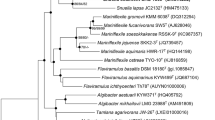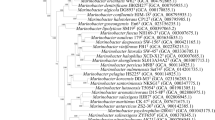Abstract
A novel bright yellow pigmented, Gram-stain-negative, gliding, aerobic and rod-shaped marine bacterium, designated strain S7007T, was isolated from a marine sediment sample taken from Jingzi Wharf, Weihai, China. The bacterium was able to grow at 4–33 °C (optimum 28 °C), at pH 6.5–9.0 (optimum 7.0) and with 2.0–4.0% (w/v) NaCl (optimum 3.0%). According to the phylogenetic analysis based on the 16S rRNA gene sequences, strain S7007T was associated with the genus Tenacibaculum and showed highest similarity to Tenacibaculum adriaticum JCM 14633T (98.0%). The average nucleotide identity (ANI) scores of strain S7007T with T. adriaticum JCM 14633T and T. maritimum NBRC 110778T were 78.3% and 77.1%, respectively and the Genome-to-Genome Distance Calculator (dDDH) scores were 20.5% and 19.9%, respectively. The sole isoprenoid quinone was MK-6 and the major cellular fatty acids (> 10.0%) were iso-C15:0, iso-C15:0 3-OH, iso-C15: 1 G and summed feature 3 (comprising C16:1 ω7c and/or C16:1 ω6c). The major polar lipids of strain S7007T were phosphatidylethanolamine, phosphatidyldimethylethanolamine, one unidentified lipid and two unidentified aminolipids. The genomic DNA G + C content was 30.9 mol %. The combined phenotypic data and phylogenetic inference that strain S7007T should be classified as a novel species in the genus Tenacibaculum, for which the name Tenacibaculum pelagium sp. nov. is proposed. The type strain is S7007T (= MCCC 1H00428T = KCTC 72941T).

Similar content being viewed by others
Data availability
The GenBank accession number for the 16S rRNA gene sequence and whole-genome shotgun project of strain S7007T are MT822280 and JACGLS000000000, respectively.
Abbreviations
- JCM:
-
Japan Collection of Microorganisms
- MCCC:
-
Marine Culture Collection of China
- NBRC:
-
Biological Resource Center
- KCTC:
-
The Korean Collection for Type Cultures
- ANI:
-
Average nucleotide identity
- GGDC:
-
Genome-to-Genome Distance Calculator
- dDDH:
-
Digital DNA–DNA hybridization
- MEGA:
-
Molecular Evolutionary Genetics Analysis
- MIDI:
-
Microbial Identification System
- HPLC:
-
High Performance Liquid Chromatography
- TLC:
-
Thin layer chromatography
References
Angiuoli SV, Gussman A, Klimke W, Cochrane G, Field D et al (2008) Toward an online repository of Standard Operating Procedures (SOPs) for (meta)genomic annotation. OMICS 12:137–141
Auch AF, Von Jan M, Klenk HP, Göker M (2010) Digital DNA-DNA hybridization for microbial species delineation by means of genome-to-genome sequence comparison. Stand Genomic Sci 2:117–134
Bernardet JF (2011) Family I. Flavobacteriaceae Reichenbach 1992. In: Krieg NR, Staley JT, Brown DR, Hedlund BP, Paster BJ et al (eds) Bergey’s manual of systematic bacteriology, vol 4, 2nd edn. Springer, New York, pp 106–111
Bernardet JF, Nakagawa Y, Holmes B (2002) Proposed minimal standards for describing new taxa of the family Flavobacteriaceae and emended description of the family. Int J Syst Evol Microbiol 52:1049–1070
Biebl H, Pukall R, Lünsdorf H, Schulz S, Allgaier M, Tindall BJ, Wagner-Dobler I (2007) Description of Labrenzia alexandrii gen. nov., sp. nov., a novel alphaproteobacterium containing bacteriochlorophyll a, and a proposal reclassification of Stappia aggregata as Labrenzia aggregata comb. nov., and of Stappia alba as Labrenzia alba comb. nov. Int J Syst Evol Microb 57:1095–1107
Blin K, Shaw S, Steinke K (2019) antiSMASH 5.0: updates to the secondary metabolite genome mining pipeline. Nucleic Acids Res 47:W81–W87
Clotault J, Peltier D, Soufflet-Freslon V, Briard M, Geoffriau E (2012) Differential selection on carotenoid biosynthesis genes as a function of gene position in the metabolic pathway: a study on the carrot and dicots. PLoS ONE 7:38724
CLSI (2012) Performance standards for antimicrobial susceptibility testing, twenty-second informational supplement CLSI document M100–S22. Clinical and Laboratory Standards Institute, Wayne
Cowan ST, Steel KJ (1974) Bacterial characters and characterization, 2nd edn. Cambridge University Press, Cambridge, UK
Du ZJ, Wang Y, Dunlap C, Rooney AP, Chen GJ (2014) Draconibacterium orientale gen. nov., sp. nov., isolated from two distinct marine environments, and proposal of Draconibacteriaceae fam. nov. Int J Syst Evol Microbiol 64:1690–1696
Fang DB, Han JR, Liu Y, Du ZJ (2017) Seonamhaeicola marinus sp. nov., isolated from marine algae. Int J Syst Evol Microbiol 67:4857–4861
Felsenstein J (1981) Evolutionary trees from DNA sequences: a maximum likelihood approach. J Mol Evol 17:368–376
Felsenstein J (1985) Confidence limits on phylogenies: an approach using the bootstrap. Soc Study Evol 39:783–791
Fitch WM (1971) Towards defining the course of evolution: minimal change for a specified tree topology. Syst Zool 20:406–416
Goris J, Konstantinidis KT, Klappenbach JA, Coenye T, Vandamme P, Tiedje JM (2007) DNA-DNA hybridization values and their relationship to whole-genome sequence similarities. Int J Syst Evol Microbiol 57:81–91
Hansen GH, Bergh O, Michaelsen J (1992) Flexibacter ovolyticus sp. nov., a pathogen of eggs and larvae of Atlantic halibut, Hippoglossus hippoglossus L. Int J Syst Bacteriol 42:451–458
Heindl H, Wiese J, Imhoff JF (2008) Tenacibaculum adriaticum sp. nov., from a bryozoan in the Adriatic Sea. Int J Syst Evol Microbiol 58:542–547
Jung SY, Oh TK, Yoon JH (2006) Tenacibaculum aestuarii sp. nov., isolated from a tidal flat sediment in Korea. Int J Syst Evol Microbiol 56:1577–1581
Kanehisa M, Goto S, Kawashima S, Nakaya A (2002) The KEEG databases at GenomeNet. Nucleic Acids Res 30:42–46
Kang SJ, Lee SY, Lee MH, Oh TK, Yoon JH (2012) Tenacibaculum geojense sp. nov., isolated from seawater. Int J Syst Evol Microbiol 62:18–22
Kimura M (1980) A simple method for estimating evolutionary rates of base substitutions through comparative studies of nucleotide sequences. J Mol Evol 16:111–120
Kim OS, Cho YJ, Lee K, Yoon SH, Kim M, Na H, Park SC, Jeon YS, Lee JH, Yi H, Won S, Chun J (2012) Introducing EzTaxon-e: a prokaryotic 16S rRNA gene sequence database with phylotypes that represent uncultured species. Int J Syst Evol Microbiol 62:716–721
Kim YO, Park S, Nam BH (2013) Tenacibaculum halocynthiae sp. nov., a member of the family Flavobacteriaceae isolated from sea squirt Halocynthia roretzi. Antonie Van Leeuwenhoek 103:1321–1327
Kroppenstedt RM (1982) Separation of bacterial menaquinones by HPLC using reverse phase (RP18) and a silver loaded ion exchanger as stationary phases. J Liq Chromatogr 5:2359–2367
Kumar S, Stecher G, Tamura K (2016) MEGA 7: molecular evolutionary genetics analysis version 7.0 for Bigger Datasets. Mol Biol Evol 33:1870–1874
Lee I, Ouk Kim Y, Park SC, Chun, (2016) OrthoANI: An improved algorithm and software for calculating average nucleotide identity. Int J Syst Evol Microbiol 66:1100–1103
Linden H, Misawa N, Chamovitz D, Pecker I, Hirschberg J, Sandmann G (1991) Functional complementation in Escherichia coli of different phytoene desaturase genes and analysis of accumulated carotenoids. Z Naturforsch 46:1045–1051
Li R, Li Y, Kristiansen K, Wang J (2008) SOAP: short oligonucleotide alignment program. Bioinformatics 24:713–714
Li R, Zhu H, Ruan J, Qian W, Fang X, Shi Z, Li Y, Li S, Shan G, Kristiansen K, Li S, Yang H, Wang J, Wang J (2010) De novo assembly of human genomes with massively parallel short read sequencing. Genome Res 20:265–272
Liu QQ, Li XL, Rooney AP, Du ZJ, Chen GJ (2014) Tangfeifania diversioriginum gen. nov., sp. nov., a representative of the family Draconibacteriaceae. Int J Syst Evol Microbiol 64:3473–3477
Meier-Kolthoff JP, Auch AF, Klenk HP, Göker M (2013) Genome sequence-based species delimitation with confidence intervals and improved distance functions. BMC Bioinformatics 14:60
Minnikin DE, O’Donnell AG, Goodfellow M, Alderson G, Athalye M, Schaal A, Parlett JH (1984) An integrated procedure for the extraction of bacterial isoprenoid quinones and polar lipids. J Microbiol Methods 2:233–241
Miyake S, Soh M, Azman MN (2020) Insights into the microbiome of farmed Asian sea bass (Lates calcarifer) with symptoms of tenacibaculosis and description of Tenacibaculum singaporense sp. nov. Antonie Van Leeuwenhoek 113:737–752
Oh YS, Kahng HY, Lee DH (2012) Tenacibaculum jejuense sp. nov., isolated from coastal seawater. Int J Syst Evol Microbiol 62:414–419
Sverre BS, Øyvind JB, Henrik D, Karl FO, Kuninori W, Are N (2016) Tenacibaculum finnmarkense sp nov., a fish pathogenic bacterium of the family Flavobacteriaceae isolated from Atlantic salmon. Antonie van Leeuwenhoek: J Microbiol Serol 109:273–285
Reichenbach, H (1989) Order I. Cytophagales Leadbetter 1974, 99AL. In: Staley JT, Bryant MP, Pfennig N & Holt JC. Williams & Wilkins co., Baltimore. pp 2011–2013
Saitou N, Nei M (1987) The neighbour-joining method: a new method for reconstructing phylogenetic trees. Mol Biol Evol 4:406–425
Sasser M (1990) Identification of bacteria by gas chromatography of cellular fatty acids, MIDI Technical Note 101. MIDI Inc, Newark, DE
Smibert RM, Krieg NR (1994) Phenotypic characterization. In: Gerhardt P, Murray RGE, Wood WA, Krieg NR (eds) Methods for General and Molecular Bacteriology. American Society for Microbiology, Washington, DC, pp 607–654
Suzuki M, Nakagawa Y, Harayama S, Yamamoto S (2001) Phylogenetic analysis and taxonomic study of marine Cytophaga-like bacteria: proposal for Tenacibaculum gen. nov. with Tenacibaculum maritimum comb. nov. and Tenacibaculum ovolyticum comb. nov., and description of Tenacibaculum mesophilum sp. nov. and Tenacibaculum amylolyticum sp. nov. Int J Syst Evol Microbiol 51:1639–1652
Tao L, Yao H, Kasai H, Misawa N, Cheng Q (2006) A carotenoid synthesis gene cluster from Algoriphagus sp. KK10202C with a novel fusion-type lycopene beta-cyclase gene. Mol Genet Genomics 276:79–86
Thompson JD, Gibson TJ, Plewniak F, Jeanmougin F, Higgins DG (1997) The CLUSTAL_X windows interface: Flexible strategies for multiple sequence alignment aided by quality analysis tools. Nucleic Acids Res 25:4876–4882
Tindall BJ, Sikorski J, Smibert RM, Krieg NR (2007) Phenotypic characterization and the principles of comparative systematics. In: Reddy CA, Beveridge TJ, Breznak JA, Marzluf G, Schmidt TM et al (eds) Methods for General and Molecular Microbiology, 3rd edn. ASM Press, Washington, pp 330–393
Wakabayashi H, Hikida M, Masumura K (1986) Flexibacter maritimus sp. nov., a pathogen of marine fishes. Int J Syst Bacteriol 36:396–398
Acknowledgements
This work of scanning electron microscope was supported by the Physical-Chemical Materials Analytical & Testing Center of Shandong University at Weihai.
Funding
This work was supported by the National Natural Science Foundation of China (32070002, 31770002) and National Science and Technology Fundamental Resources Investigation Program of China (2019FY100700).
Author information
Authors and Affiliations
Contributions
Strain S7007T was isolated by Dan-Dan Shang. Material preparation, experimental operation, data collection and analysis were performed by Dan-Dan Shang, He-Yuan Lun and Ke-Lei Zhu. The manuscript was written by Dan-Dan Shang. Project guidance and critical revision of manuscripts was performed by Guan-Jun Chen and Zong-Jun Du. All authors read and approved the final manuscript.
Corresponding author
Ethics declarations
Conflict of interests
Authors declare that there is no conflict of interest.
Ethical statements
This article does not contain any studies with animals performed by any of the authors. Informed consent was obtained from all individual participants included in the study.
Additional information
Communicated by Erko Stackebrandt.
Publisher's Note
Springer Nature remains neutral with regard to jurisdictional claims in published maps and institutional affiliations.
Supplementary Information
Below is the link to the electronic supplementary material.
Rights and permissions
About this article
Cite this article
Shang, DD., Lun, HY., Zhu, KL. et al. Tenacibaculum pelagium sp. nov., isolated from marine sediment. Arch Microbiol 203, 2229–2236 (2021). https://doi.org/10.1007/s00203-021-02208-7
Received:
Revised:
Accepted:
Published:
Issue Date:
DOI: https://doi.org/10.1007/s00203-021-02208-7




